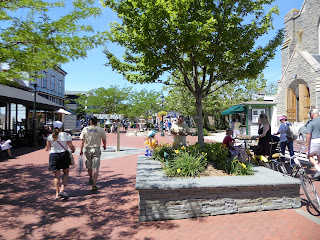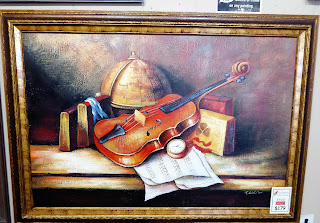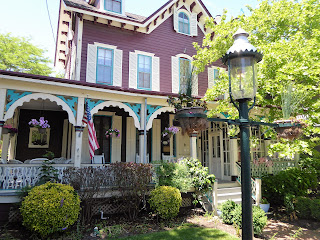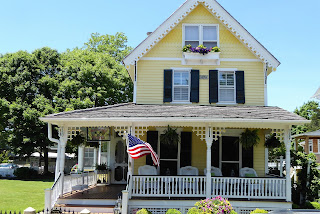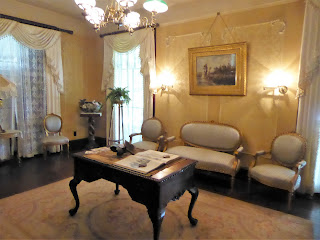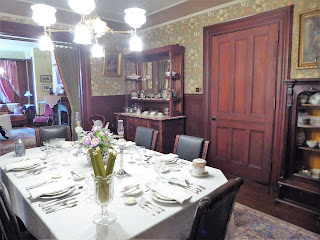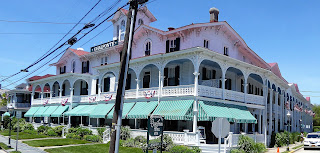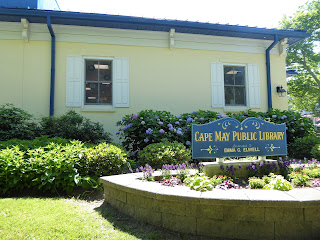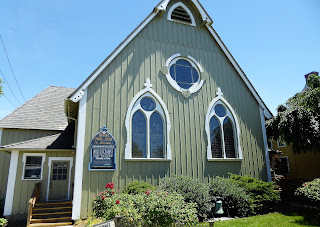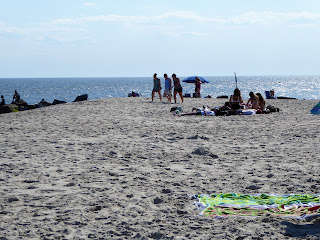Below are a few pictures of a place we rented during a recent summer visit. Penn Realty provided us with nearly everything we needed, from place settings, to paper products and more to ensure that our stay would be a comfortable one.
 |
| A four-bedroom rental on Princeton. |
 |
| The rear of the property. |
 |
| The sprawling front porch. Not quite unplugged, but tranquil nonetheless. |
 |
| The spacious kitchen included everything to entertain. |
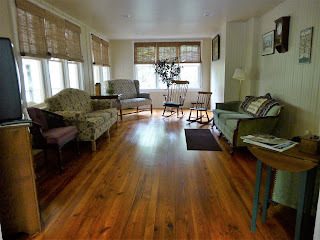 |
| The living room. |
It comes as a surprise to some that Mount Gretna was modeled after New York's Chautauqua, which was established in 1874 in New York State. The movement began as an outdoor educational experience for Sunday school teachers and grew in popularity until automobiles and movie theaters captured the public's attention.
When guests first visit Mt. Gretna, they'll see an imposing structure that seems a bit out of place in the little cottage community. The Hall of Philosophy, built in 1910, was inspired by Greek architecture and looms large as one enters the enclave. To this day, it serves as a center for learning where members of the community can gather together to hear lectures on religion, learn about arts and crafts, or take part in political discussions.
 |
| When we visited this summer, a group of ladies were enjoying a game of Mahjong on the front porch of the Hall of Philosophy. |
The Mount Gretna Historical Society
Visitors can learn more about the history of the area at the Mt. Gretna Historical Society located at 206 Pennsylvania Avenue. The two-story building contains relics of years past, including a deer from a carousel that once entertained guests who visited the area.
 |
| Historical society artifacts. |
No destination is complete, (at least in my opinion), without shopping opportunities. The Gretna Emporium, located in the heart of Mount Gretna along route 117, was once the Chautauqua's Literary and Scientific Circle building. Today guests can spend time browsing yard art and other items displayed on the front porch. Inside are a variety of books, toys and unique gift items.
Enjoying Time on the Water
Mount Gretna Lake and Beach is open every year from the last weekend in May through Labor Day. The family-owned entertainment hub is a favorite for those who enjoy frolicking on the water. Canoes, tubes and kayaks are all available for rent.
Teens, in particular, seem to enjoy lining up to take their turn on a huge swing that soars high into the sky and reaches out over the lake.
For those interested in making a day of it, a snack bar and shaded picnic grove are provided and a children's playground offers hours of fun for those who visit.
 |
| Mt. Gretna Lake & Beach |
 |
| This is me in the front and Sue, otherwise known as Lucy and Ethel, when we started going off course. We made it back though. |
Seeing a Show
Theater fans have not one, but two options in the Mt. Gretna area. The Gretna Theatre, situated at the top of the hill at Carnegie and Pennsylvania Avenues, is known as one of the oldest summer theatres in the United States. Audiences have been entertained in this same location since 1927 by such notable figures as Charlton Heston, Bernadette Peters and Sally Struthers, to name just a few.
 |
| Mount Gretna Theatre sits up on a hill, not far from the Hall of Philosophy. |
 |
| The interior of the Mount Gretna Theatre |
The Timbers Restaurant and Dinner Theatre, located at 350 Timbers Road, is another venue that has been a favorite of theater fans for decades. Diners can choose from a buffet, or an ala carte meal before each performance. Owner Kathleen Roberts takes great care to hire top-notch talent, escorting her team to New York every February to audition first-class performers. She winnows down the field of talented actors to the very best and those who are talented enough to make the cut have the pleasure of performing at this beloved establishment. To see upcoming plays and times, visit their website here.
 |
| The Timbers has been a beloved family owned institution for decades. |
Guests can enjoy breakfast and lunch all year round at the homey Porch and Pantry, open Tuesday through Sunday from 8 a.m. to 1 p.m. Morning favorites include grilled sticky buns, maple French toast coffee and pancakes that are big enough to satisfy even the largest appetites. During warmer weather guests can relax outside on the spacious front porch beneath the gentle breeze of ceiling fans.
 |
| Breakfast and lunch is available year round from Tuesday through Sunday at The Porch and Pantry. |
Another perennial favorite is the popular Jigger Shop, which has been a fixture in the community for a century. For many families, it's a tradition to visit there at least once during the summer. Open daily from noon to 10 p.m., the casual eatery serves soups, salads, sandwiches and ice cream. If you're an out-of-towner interested in trying a regional specialty, you might want to give the LCB, otherwise known as the Lebanon County Banquet, a try. Made with grilled sweet bologna crafted at the nearby Seltzer's bologna plant from a recipe that has been handed down through generations, it is a unique menu item that you won't find just anywhere.
 |
| Guests enjoy ice cream on the deck of The Jigger Shop. |
One other notable eatery I must mention, located just outside Mt. Gretna, is The Divine Swine. My husband and I passed it by until this last visit. Little did we know what we were missing. The stand alone building, located across the street from the Renaissance Faire , is a casual eatery that specializes in BBQ, offering everything from pulled pork sandwiches, to brisket, chicken and ribs and cajun sausage. We placed our orders at the front counter and took a seat at a cute, high-top table made from a beer keg sporting chicken feet.
 |
| Tables at The Divine Swine. |
Annual Home and Garden Tour
 |
| An example of some of the homes you'll see in Mt. Gretna |
 |
| This home was on a tour stop a few years ago. |
On the first Saturday in August, Gretna Music hosts the Tour of Homes and Gardens. Mt. Gretna Music brings chamber music, jazz and other musical genres to Central Pennsylvania and the organization has been going strong for decades now. The popular fundraiser gives guests a glimpse inside of about a dozen homes and several gardens. Ticket prices can be found on their website. The tour starts at the post office on Princeton Avenue and at the tent in front of the Mt. Gretna Playhouse.
The Annual Outdoor Art Show
Each year, on the third Saturday in August, art lovers visit from near and far for the Mt. Gretna Outdoor Art Show. The is year number 44 for the juried exhibition, which is comprised of hundreds of exhibitors who work in a variety of mediums. A Kids Art Show features children's art and activities for the up-and-coming little artist. A food tent, live music and strolling performers are all part of the experience that runs all weekend. To learn more, follow this link.
These are just a few suggestions on how to make the most of a trip to scenic Mount Gretna, a place where generations of families return year after year to socialize, embrace the serenity and soak in nature's beautiful surroundings.




